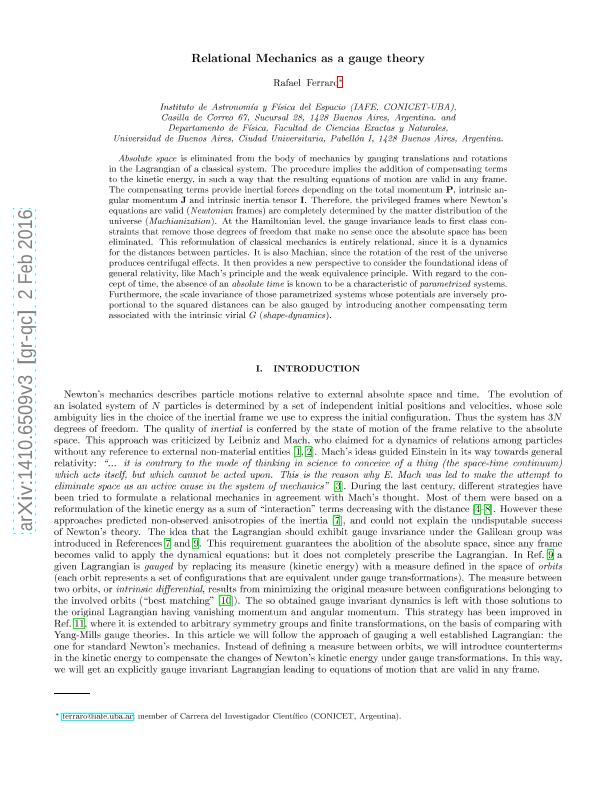Mostrar el registro sencillo del ítem
dc.contributor.author
Ferraro, Rafael

dc.date.available
2017-06-13T19:51:45Z
dc.date.issued
2016-02
dc.identifier.citation
Ferraro, Rafael; Relational mechanics as a gauge theory; Springer/plenum Publishers; General Relativity And Gravitation; 48; 23; 2-2016; 1-22
dc.identifier.issn
0001-7701
dc.identifier.uri
http://hdl.handle.net/11336/18133
dc.description.abstract
Absolute space is eliminated from the body of mechanics by gauging translations and rotations in the Lagrangian of a classical system. The procedure implies the addition of compensating terms to the kinetic energy, in such a way that the resulting equations of motion are valid in any frame. The compensating terms provide inertial forces depending on the total momentum P, intrinsic angular momentum J and intrinsic inertia tensor I. Therefore, the privileged frames where Newton?s equations are valid (Newtonian frames) are completely determined by the matter distribution of the universe (Machianization). At the Hamiltonian level, the gauge invariance leads to first class constraints that remove those degrees of freedom that make no sense once the absolute space has been eliminated. This reformulation of classical mechanics is entirely relational, since it is a dynamics for the distances between particles. It is also Machian, since the rotation of the rest of the universe produces centrifugal effects. It then provides a new perspective to consider the foundational ideas of general relativity, like Mach?s principle and the weak equivalence principle. With regard to the concept of time, the absence of an absolute time is known to be a characteristic of parametrized systems. Furthermore, the scale invariance of those parametrized systems whose potentials are inversely proportional to the squared distances can be also gauged by introducing another compensating term associated with the intrinsic virial G (shape-dynamics).
dc.format
application/pdf
dc.language.iso
eng
dc.publisher
Springer/plenum Publishers

dc.rights
info:eu-repo/semantics/openAccess
dc.rights.uri
https://creativecommons.org/licenses/by-nc-sa/2.5/ar/
dc.subject
Classical Mechanics
dc.subject
Gauge Theories
dc.subject.classification
Otras Ciencias Físicas

dc.subject.classification
Ciencias Físicas

dc.subject.classification
CIENCIAS NATURALES Y EXACTAS

dc.title
Relational mechanics as a gauge theory
dc.type
info:eu-repo/semantics/article
dc.type
info:ar-repo/semantics/artículo
dc.type
info:eu-repo/semantics/publishedVersion
dc.date.updated
2017-06-13T14:14:11Z
dc.journal.volume
48
dc.journal.number
23
dc.journal.pagination
1-22
dc.journal.pais
Estados Unidos

dc.journal.ciudad
Nueva York
dc.description.fil
Fil: Ferraro, Rafael. Consejo Nacional de Investigaciónes Científicas y Técnicas. Oficina de Coordinación Administrativa Ciudad Universitaria. Instituto de Astronomía y Física del Espacio. - Universidad de Buenos Aires. Facultad de Ciencias Exactas y Naturales. Instituto de Astronomía y Física del Espacio; Argentina
dc.journal.title
General Relativity And Gravitation

dc.relation.alternativeid
info:eu-repo/semantics/altIdentifier/doi/http://dx.doi.org/10.1007/s10714-016-2018-5
dc.relation.alternativeid
info:eu-repo/semantics/altIdentifier/url/https://arxiv.org/abs/1410.6509
dc.relation.alternativeid
info:eu-repo/semantics/altIdentifier/url/https://link.springer.com/article/10.1007/s10714-016-2018-5
Archivos asociados
